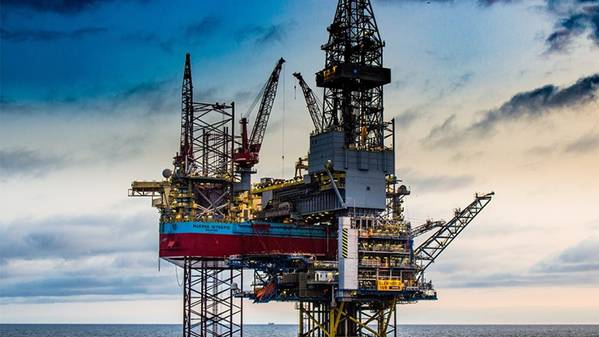
Danish rig operator Maersk Drilling has announced what it's calling the first hybrid, low-emission drilling rig, based on the Norwegian Continental Shelf.
Through a series of upgrades, Maersk Drilling aims to convert the Maersk Intrepid ultra-harsh environment jack-up rig into a hybrid rig with low levels of NOx emissions, adding data intelligence to further reduce energy consumption and CO2 emissions.
The upgrades are being carried out in cooperation with Maersk Intrepid’s current customer, Equinor, which has introduced compensation formats to stimulate emission reductions.
Maersk Intrepid is an ultra-harsh environment XLE jack-up rig which was built in 2014. It is currently contracted to Equinor for operational support on the Martin Linge field offshore Norway.
The first upgrade of Maersk Intrepid will be the installation of batteries for the hybrid power solution which is expected to be completed in July this year. The full implementation of all low-emission upgrades is expected to be completed by the end of 2019, and Maersk Drilling will use the learnings from Maersk Intrepid to evaluate how to proceed with potential upgrades to reduce emissions from other Maersk Drilling rigs.
"Combining hybrid power, data intelligence and cleaning technology, the Maersk Intrepid will push the boundaries for low-emission drilling on conventionally powered offshore rigs," says the Danish based drilling company.
The low-emission package introduced on the rig consists of three upgrades in total, comprising hybrid power, energy emission efficiency software, and selective catalytic reduction systems (SCRs).
The energy use on board a rig is characterised by high peak loads during certain operations. By installing energy storage by use of batteries, the rig will have power instantly available when needed, meaning that basic energy requirements can be met by fewer engines operating at higher intensity – which is both more efficient and reduces CO2 emissions.
The cloud-based Energy Emission Efficiency (EEE) software developed by Maersk Drilling uses real-time data to monitor all energy use on board the rig, which allows for continuous optimisation, for example by switching off engines when they are not needed. Live tests of EEE have demonstrated a double-digit energy saving potential under test conditions.
Selective Catalytic Reduction (SCR) systems capture NOx exhausts and use ammonia injections to convert the gas into harmless water and nitrogen. By installing SCR units on all the rig’s engine exhaust pipes, Maersk Drilling expects to be able to reduce NOx emissions by more than 90%, while also reducing soot emissions significantly.
Maersk Drilling successfully applied for project funding through the NOx Fund, a Norwegian industry fund dedicated to reducing NOx emissions. The fund is contributing a grant of up to 80% of project costs, subject to verification of the emission-reducing upgrades.
“The NOx Fund has requested these types of emission reduction projects for a long time, and finally they are being realised. Here Maersk Drilling takes the lead by showing that cost-efficient measures to significantly reduce NOx can be combined with reduced CO2 emissions and improved fuel efficiency. Hopefully we will see more of these and similar solutions on board rigs going forward,” says Tommy Johnsen, General Manager of the NOx Fund.
“The Maersk Intrepid project is the result of asking a simple yet challenging question: What would be the most efficient technological approach to minimising emissions from a rig in the short term? The resulting ideas have been very positively received by Equinor and will contribute to Equinor’s long-term emission targets. It should be noted that the upgrades will not only produce a low-emission profile for the rig; they will also result in cost savings for our customer due to lower energy consumption, so this is business and low-emission targets working hand in hand,” says CCIO Morten Kelstrup of Maersk Drilling.
“We observe a strong drive from both authorities and the industry on energy efficiency and emissions. With this combined solution, Maersk Intrepid will provide important data and learnings to build from,” says CCIO Morten Kelstrup of Maersk Drilling.


